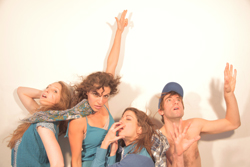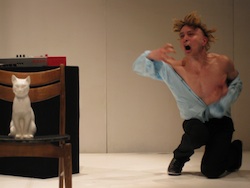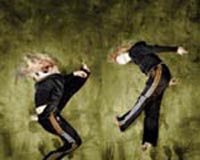Sasha Ivanochko and Audrey Lehouillier are a study in contrasts. Together on the same bill, they explore the inner lives of women, but also show their differences to good measure. Ivanochko is originally from Toronto, but now shuttles between that city and Montréal. She is small in stature and a powerful, compact dancer who is sure of foot, and her choreography displays order, simplicity and moderation. Lehouillier, a Québec City native, came to Montréal to study at Les Ateliers de danse moderne de Montréal, and has been creating her own work since 1998. She’s tall, slender and rangy, with long expressive arms and legs. Like Ivanochko, she’s an emerging dance-maker that I feel is growing into her choreographic self. On a triple bill, along with Japanese-based dancer-choreographer Kunie Suzuki, they performed their own solo works at Tangente’s annual celebration of women in dance, SaGeste, a program that coincides with International Women’s Week. (For the purposes of this review, I’m only writing about the Canadian works).
Ivanochko’s “Is this love?” begins with the dancer close to the audience, her back to the crowd, her body caught by a spot of light. She is wearing a simple chocolate-brown patterned sleeveless dress. There is utter calm in her stance; yet, there’s a forlorn sense here. This solitary figure reaches upwards, one arm pitched skyward. It is the most significant gesture in the piece, and is re-examined later in the work.
The sound design, composed by Catherine Thompson, starts off with a metallic banging, like hands on aluminum sheets. As Ivanochko raises her head, the sound stops. She juts her hip to the side, her upper body weaves and she sinks to one knee. When she rises again, on both feet, her upper body pivots, her legs spread apart, taut. Whatever else one understands about the dance thus far, one thing is certain — Ivanochko has intelligence and strength in her body.
She moves upstage, turns and faces the light. Thompson’s score modulates to guitar that becomes increasingly twangy and cacophonous. Later, Ivanochko moves accompanied by the sounds of a dryer being turned on and off. Her head cocks up and her eyes dart to the side. There’s something strangely amusing and sly about the gesture. She plays off-balance, slightly shifting her centre.
If there is rumbling inside this woman, there’s also something impenetrable about her, and indeed this work seems contained and reserved. And even though nothing boils over, something is brewing. In the final moments of the piece, Ivanochko skips herself in circles as the lights fade to blackness. It’s as if she has been presenting the strengthening of the body, the freeing of its channels. It’s a private journey and, as it happens, a deeply felt public rite.
Lehouillier’s “hypnotic” follows last season’s “Bleue”, which in French indicates not only a colour but also an emotional tone. She performed that solo dance too. Both these works are light years from her flamboyant theatrical work of the past. She used to be extravagant with her pieces, with lots of colourful design elements, pulsing club music, and casts of dancers; but even with the extravagant colour and imagery, and the seemingly impetuous intent, she was judicious in her use of materials. Again in “hypnotic”, like in “Bleue”, she has stripped her process down and is looking inwards.
Gone is any sense of pretense; what we get here are emotional and physical basics. At the start of the dance all we see is her palm bathed in light. Then the square of light in the centre of the stage grows to incorporate Lehouillier’s full body. On a full screen at the back of the theatre, her palm appears as well, and then it doubles and fades, the first in a series of doppelganger passages in the piece (video projections by Lehouillier and Matt Faulkner).
In this new work, Lehouillier presents an interesting question: is her flesh-and-bones self subordinate to her image projected on the big screen behind her? We see her body writ large on the screen, morphing into twinning mode, though never in full-body shots. For instance, the upper torso doubles and then, through technological wonder, is swallowed into what initially and momentarily can only be described as a blob, which then fans into another double-image position. As this mirror imaging plays out on screen, Lehouillier remains on stage, still dancing (but not duplicating what’s on the screen) live in front of the audience, or she returns to the stage after a brief absence.
In dance terms, the jumps and oppositional pulls of her movements certainly conform to club culture standards. Wearing dark pants and simple coloured t-shirts (there are a couple of costume changes), Lehouillier works with big out-flung gestures. She jumps into an upright vertical position; she pitches her legs apart; she bends at the waist and twists in and then extends her torso, her arms stretching out, playing the horizontal line. She engages in precise poses that tend to be a bit static but give us time to contemplate what we see. Have we grown accustomed to shifting our attention from one thing to the next, never pausing to examine things properly? Have we lost our feeling for subtlety? Is television to blame? It seems we rarely have an opportunity to discover things for ourselves. Leisurely-paced Lehouillier gives us time to engage and to absorb the shapes and images before us.
Lehouillier doesn’t have Ivanochko’s proficiency and precision, or even the toughness in her attack on movement. She could use some of her colleague’s power and drive, and more centering, but her meditative introspection is rare. There’s gentleness and a quiet probing to her investigation. The music secures the reflective identity of the piece — Lehouillier uses several tracks from the New York indie band Interpol (the brooding and dark debut album, “Turn On The Bright Lights”, and the sophomore recording “Antics” that explores emotional blues, but is far more driving and upbeat).
Innovative lighting by Lucie Bazzo (for instance, the silhouetted Lehouillier dancing against the immense red screen is a sight to see), the editing in the visual montage and unusual perspectives offered by the filmed images, allow us to immerse ourselves in the movement of the real-time body and its mirror-imaging doubles on screen. Repetition — both live and on screen — makes it possible to experience gradual, barely perceptible changes and shifts in the body. The resulting images intensify the experience of looking and make us more conscious of our perception.
In five sections, “hypnotic” is notable for its play with light and the fanciful full screen video projections in which we observe the dancer as she doubles, contorts, morphs, the body composing, decomposing and disappearing, all within seconds. In this new piece, Lehouillier pares the gestures down to their essential, weaving phrases and poses into the groove. None of what she’s created is terribly musical, rhythmic, or virtuosic; but the overall conceit is successfully atmospheric and felt.
Tagged: Contemporary, Performance, Montréal , QC





